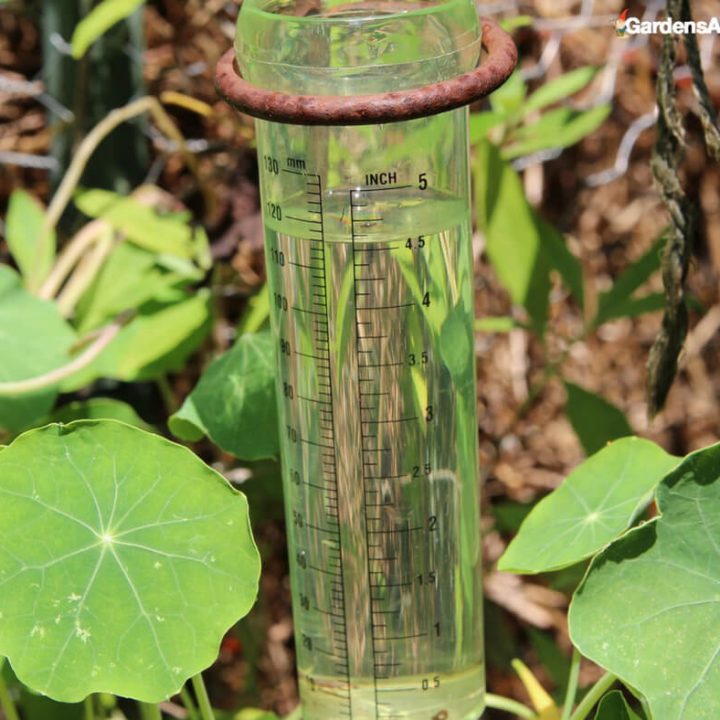We wanted rain and when it finally came, it poured… and poured… and poured some more! Then we saw the sawfly.
What a week! Our garden rain gauge showed nearly 5 inches after 3 days of thunderstorms. Thursday, it began to dry out and we applied Serenade fungus spray to our tomatoes and Dipel to the kale, cabbage and broccoli. Opportunistic cabbage worms had gone right back to work on the leaves once the rains had done away with the last treatment of powder.
Audio Article: Rain, Sawfly Larvae, Cucumber Recipe and More
Sawfly Larvae Infesting our Dogwood
Dipel Bt to the Rescue… Again!
Speaking of wormy-like pests, we discovered an infestation of sawfly larvas—those fuzzy white crawlies that look like caterpillars—on our red twig dogwood bush. As you can see, they consumed about 50% of the leaves before we spied them. Being organic-based growers, the only thing we had on hand was Dipel which was liberally applied. Experts claim Dipel and other forms of Bt are ineffective in controlling sawfly larvas. This is because they aren’t true caterpillars, but rather a sort of stingless wasp. But Dipel was all we had. Well, lo and behold: The second photo is about two hours later. By the end of the day, they were all gone!
We applied Dipel (Bacillus thuringiensis or Bt) and by the end of the day, the dogwood sawfly larvae infestation was gone.
~Coleman Alderson, GardensAll.com


Dipel (Bacillus thuringiensis or Bt)
How Dipel Insecticide Works
Dipel (Bacillus thuringiensis or Bt) packs a one-two punch. It contains protein crystals that scour the inner lining of the caterpillar as it feeds. Dipel spores then enter the lesioned gut wall and spread rapidly through the system causing blood poisoning. The larvae stops eating in a few minutes and dies within 1-3 days. [1]https://www.biorationalapproach.com/how-bt-works/ How or why it affected the sawfly larvas is a mystery, but, hey, we’ll gladly accept this exception.
How to Apply Dipel Dust
We use both liquid and powdered typed of Dipel Bt. The best way we’ve found to apply the powder as a fine dust is with an old nylon stocking filled with the stuff and lightly jiggled over the plant. We tie ours off at the end of an old broomstick for an extended reach.

Tomatoes Split and Cracked (As Expected)
Sure enough, we found a handful of tomatoes that had splits and cracks due to the heavy rains. We covered this prospect in our last newsletter. Thankfully, most of our crop is still green. We sorted through the ones we picked, tossed a couple that already had ants and sow bugs, wound up with three quasi-ripe tomatoes. One has already turned bad and the two remaining will be cut up for soup today. Win some, lose some, and make some soup!

Got Loads of Cukes? Try This!
By the way, we tried out a new recipe that used up a large bin of garden cucumbers: cucumber soup made with a blender and served cold. Man! Is it delicious!
Cold Cucumber Yogurt Soup Recipe
We didn’t have all the ingredients on hand, such as fresh tarragon, dill and shallots, so that below is adapted from the original recipe from FoodAndWine.com[2]https://www.foodandwine.com/recipes/cold-cucumber-soup-yogurt-and-dill
INGREDIENTS:
- Oversized pickle cucumbers (2 1/4 pounds), halved-any cucumber variety will do
- 1 1/2 cups plain organic yogurt
- 3 tablespoons fresh organic lemon juice
- 1 garlic clove
- 1/2 medium red onion, chopped
- 1/3 cup loosely packed fresh dill (or ~1/4 cup dried)
- 1/4 cup fresh curly parsley, finely chopped
- 2 tablespoons loosely packed tarragon leaves (or 1 Tbsp dry)
- 1/4 cup organic olive oil
- 1 teaspoon salt (or to taste)
Step 1
In a blender*, combine the chopped cucumber with the yogurt, lemon juice, onion, garlic, dill, parsley, tarragon and the 1/4 cup of olive oil. Blend until smooth. Season with salt and pepper, cover and refrigerate for at least 8 hours or overnight.
We use a Vitamix that we’ve had for years and we refrigerate the soup in the blender pitcher so that we can give it another blending just before serving.
Step 2
Taste and add additional seasonings as needed, give it another whir in the blender, then pour the soup into bowls. Garnish with the finely sliced or diced cucumber, red onion, a sprig of parsley or dill, and a drizzle of olive oil and serve.
And of course this recipe is very adaptable to whatever seasonings and herbs you have on hand.

Rained Out
It’s been a short gardening week due to our three days of rain. We hope any of you experiencing this dry hot spell also saw some relief. We’re back to gardening in a steam sauna now. As the weatherman says, “Enjoy the weather ’cause it’s the only weather you got!”
Have you anything to share about your week? Are you a fan of Dipel or other “biotics”? You can post comments and/or photos up on our Facebook page, or send us an email. We love to hear from you and learn what you’re doing and your wins and lessons.
May your gardens flourish and your harvests be bountiful, and when you look upon your little Eden, may you see that it is good.
~Coleman Alderson, GardensAll.com

Tally hoe!
~ Coleman for GardensAll.com
Keep on Growing!
G. Coleman Alderson is an entrepreneur, land manager, investor, gardener, and author of the novel, Mountain Whispers: Days Without Sun. Coleman holds an MS from Penn State where his thesis centered on horticulture, park planning, design, and maintenance. He’s a member of the Phi Kappa Phi Honor Society and a licensed building contractor for 27 years. “But nothing surpasses my 40 years of lessons from the field and garden. And in the garden, as in life, it’s always interesting because those lessons never end!” Coleman Alderson
References

